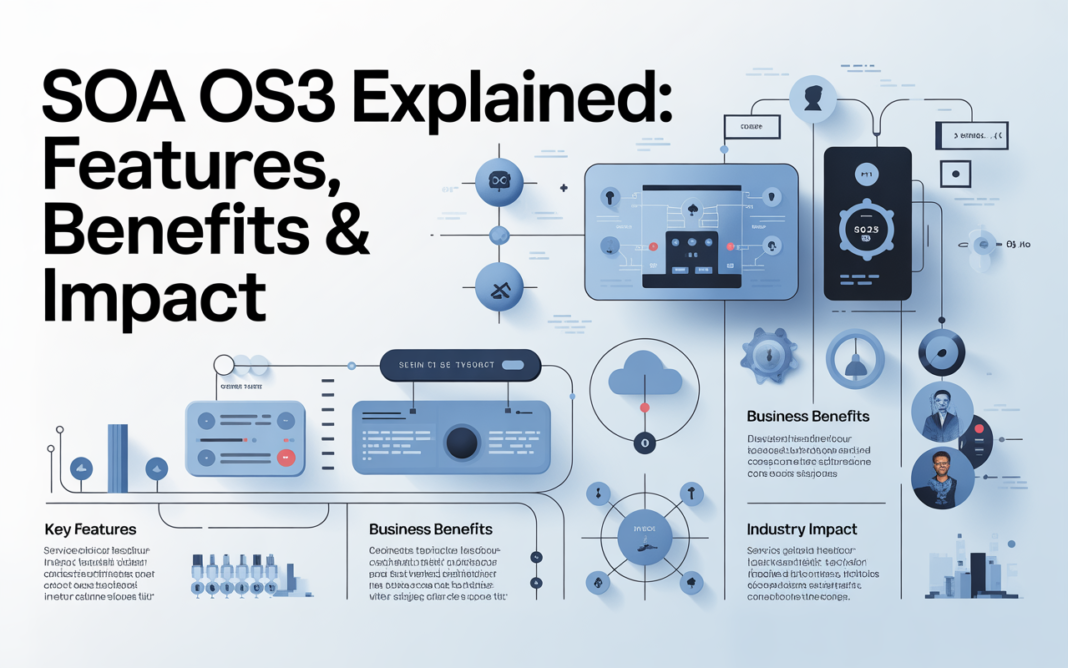Introduction: The Rise of SOA OS23
In today’s fast-paced digital landscape, technology evolves faster than ever. Systems that were once considered advanced quickly become outdated, replaced by more efficient, scalable, and intelligent solutions. Among the most innovative developments in recent years is SOA OS23, a next-generation system built on the principles of Service-Oriented Architecture (SOA).
But what makes SOA OS23 so transformative? Why are businesses, developers, and IT experts paying close attention to this emerging operating system?
This detailed guide will break down everything you need to know about SOA OS23 — from its core features and structure to its real-world applications, benefits, and impact on the global technology landscape. Whether you’re a tech enthusiast, an enterprise leader, or a developer seeking better system integration, this comprehensive overview will help you understand why SOA OS23 is redefining digital operations.
What Is SOA OS23?
At its core, SOA OS23 stands for Service-Oriented Architecture Operating System 2023 edition (or version 23). It’s designed to support modular, service-based communication across different applications and platforms.
Rather than functioning as a monolithic structure where all parts are tightly bound, SOA OS23 allows each service or component to operate independently while still working together through a shared communication protocol.
This architectural approach enhances scalability, flexibility, and interoperability, making SOA OS23 ideal for modern enterprises managing complex IT ecosystems that span cloud, IoT, AI, and hybrid systems.
The Concept Behind SOA (Service-Oriented Architecture)
Before diving into the specifics of SOA OS23, it’s important to understand the foundation it’s built on: Service-Oriented Architecture.
SOA is a design paradigm where software components (called “services”) are created as independent, reusable modules that communicate via a common interface. These services can be used across different applications, saving time, reducing costs, and improving agility.
In traditional systems, updating one feature often required modifying the entire application. With SOA, each service can be modified or replaced independently — allowing for faster innovation, seamless integration, and easier scalability.
SOA OS23 takes this principle and integrates it into an operating system framework, optimizing how services interact, communicate, and evolve.
Key Features of SOA OS23
The power of SOA OS23 lies in its advanced, modular structure and adaptability. Below are the standout features that make it a groundbreaking innovation in system architecture:
1. Modular Architecture
SOA OS23 is designed with modularity at its core. Each component functions as a separate, independent unit that can be developed, deployed, or scaled without disrupting the system. This makes upgrades, maintenance, and feature expansion far more efficient.
2. Cross-Platform Integration
In today’s interconnected world, systems need to communicate across multiple environments. SOA OS23 supports seamless integration with cloud platforms, IoT devices, mobile apps, and on-premises servers, ensuring smooth data exchange and collaboration between technologies.
3. Enhanced Security Framework
Security is one of the biggest challenges in modern IT infrastructure. SOA OS23 features an AI-driven security system with real-time monitoring, threat detection, and automatic vulnerability patching. The system also supports advanced encryption and zero-trust architecture to ensure the safety of data across all services.
4. AI and Machine Learning Optimization
Unlike traditional operating systems, SOA OS23 is powered by integrated machine learning algorithms that analyze usage patterns, predict system needs, and optimize performance automatically. This self-learning capability reduces downtime and improves operational efficiency.
5. Scalable Performance
Scalability is critical for organizations managing fluctuating workloads. SOA OS23 adapts dynamically — whether you’re running a startup with small-scale operations or a global enterprise handling massive data traffic.
6. Real-Time Analytics and Monitoring
The built-in analytics dashboard provides live performance insights, helping administrators monitor metrics like speed, security status, and network health. This visibility helps businesses make data-driven decisions faster.
7. Simplified Development Environment
Developers love SOA OS23 for its simplified service deployment model, robust API support, and low-code integration tools. These allow faster development cycles and smoother deployment of new services.
8. Cloud-Native Compatibility
SOA OS23 is fully compatible with public, private, and hybrid clouds, enabling effortless migration and deployment in modern digital ecosystems. It also integrates seamlessly with major providers like AWS, Azure, and Google Cloud.
Benefits of SOA OS23
The advantages of SOA OS23 extend far beyond its architecture. Its implementation brings tangible improvements in efficiency, security, and cost-effectiveness. Let’s explore the most significant benefits below:
1. Greater Flexibility and Agility
The modular design of SOA OS23 allows businesses to adapt quickly to market changes. Teams can add, remove, or modify individual services without affecting the entire system, giving organizations the agility they need in fast-changing industries.
2. Cost Efficiency
By reusing existing services and reducing redundant development, SOA OS23 significantly cuts operational costs. Businesses no longer need to rebuild components from scratch, which saves both time and resources.
3. Faster Time-to-Market
With SOA OS23, new applications and updates can be deployed quickly. Its reusable services and streamlined deployment pipeline allow faster product launches — a key advantage in competitive industries.
4. Improved Collaboration
Different teams within an organization can work on separate services simultaneously, increasing collaboration without dependency bottlenecks. This parallel development approach accelerates innovation.
5. Enhanced Security and Reliability
The AI-based protection and modular isolation features of SOA OS23 reduce the risk of system-wide failure. If one service encounters an issue, it can be isolated and fixed independently, maintaining overall system stability.
6. Future-Proof Infrastructure
With cloud-native compatibility and scalable design, SOA OS23 is built to evolve with future technologies like AI integration, blockchain support, and advanced automation. It’s not just a system for today — it’s a foundation for tomorrow’s digital ecosystem.
SOA OS23 vs. Traditional Systems
| Feature | SOA OS23 | Traditional Systems |
|---|---|---|
| Architecture | Modular & Service-Oriented | Monolithic & Centralized |
| Scalability | Highly scalable | Limited scalability |
| Security | AI-driven & adaptive | Manual, reactive |
| Integration | Cross-platform & cloud-native | Often restricted or siloed |
| Cost Efficiency | Reusable services reduce costs | Rebuilding required for updates |
| Deployment | Continuous & automated | Manual & time-consuming |
| Performance | Optimized through AI | Static performance |
This comparison shows how SOA OS23 redefines system efficiency, adaptability, and security, making it a superior choice for modern enterprises.
The Impact of SOA OS23 on Modern Technology
The release of SOA OS23 has had a profound influence across various sectors, from enterprise IT and software development to digital transformation strategies worldwide.
1. Revolutionizing Enterprise Operations
Enterprises rely on multiple applications that need to communicate effectively. SOA OS23 simplifies this communication, enabling systems to share data effortlessly. This streamlines workflows and enhances productivity.
2. Empowering Developers
For developers, SOA OS23 provides a robust and flexible environment that reduces complexity. Its API-first design and modular approach promote rapid development and testing.
3. Advancing Cloud Computing
As organizations migrate to cloud-based infrastructure, SOA OS23 acts as a bridge — providing seamless interoperability between local and cloud services.
4. Driving Innovation in Automation
With built-in AI and automation, SOA OS23 enables predictive maintenance, intelligent system adjustments, and resource allocation — minimizing downtime and maximizing efficiency.
5. Supporting Sustainable IT Growth
By reducing redundancy and optimizing performance, SOA OS23 contributes to sustainable computing practices, lowering energy consumption and hardware dependency.
Real-World Applications of SOA OS23
The versatility of SOA OS23 makes it applicable across multiple industries:
-
Finance: For secure, real-time transaction processing.
-
Healthcare: For managing interconnected patient data systems.
-
Manufacturing: To streamline automation and IoT integration.
-
Retail: For managing omnichannel platforms efficiently.
-
Education: Enabling cloud-based learning systems with modular scalability.
Challenges and Limitations
Despite its many strengths, SOA OS23 isn’t without challenges:
-
Implementation Complexity: Transitioning from older systems to SOA OS23 may require retraining and infrastructure upgrades.
-
Governance Issues: Managing multiple services can become complex without a solid governance model.
-
Initial Costs: While long-term savings are substantial, the initial setup can be resource-intensive.
However, these challenges are easily outweighed by the system’s long-term scalability and adaptability.
The Future of SOA OS23
The future of SOA OS23 looks incredibly promising. As businesses increasingly move toward automation, AI integration, and decentralized systems, SOA OS23’s service-oriented design positions it as a cornerstone of next-generation IT ecosystems.
Future updates are expected to enhance quantum computing compatibility, cybersecurity protocols, and edge computing integration, making SOA OS23 even more versatile and efficient.
Conclusion: Why SOA OS23 Matters
In a world driven by innovation, speed, and data, SOA OS23 stands as a technological breakthrough that transforms how systems communicate and perform.
Its modular structure, AI optimization, and scalable design empower organizations to operate smarter, faster, and more securely. From improving collaboration to reducing operational costs, SOA OS23 is more than just a system—it’s a strategic advantage for businesses preparing for the future of digital transformation.



